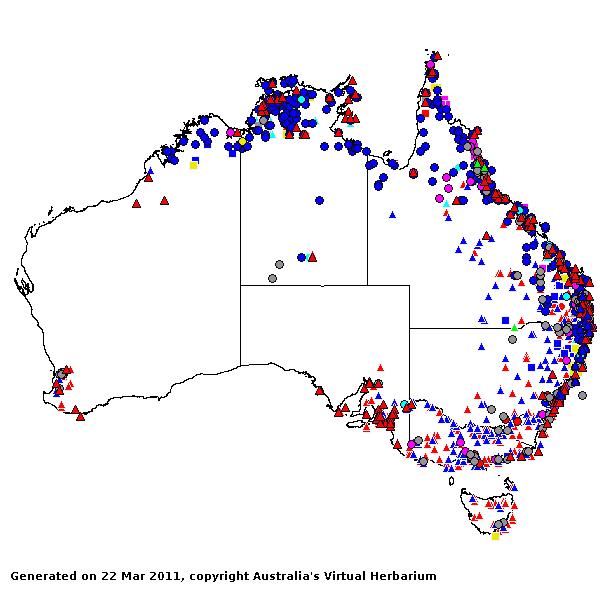Paspalum Syst. Nat. ed.10. 855, 1359 (1759).
Derivation:. From Greek paspalos (millet).
Key references (keys and floras):. G.Bentham, Flora Australiensis 7: 459–462 (1878); C.A.Gardner, Flora of Western Australia 1 Gramineae 240–242 (1952); J.W.Vickery, Flora of New South Wales, Gramineae 19: 115–122 (1961); E.E.Henty, Manual Grasses New Guinea 144–146 (1969); M.Lazarides, Tropical Grasses S.E. Asia 132–134 (1980); J.C.Tothill and J.B.Hacker, Grasses of Southern Queensland 332–334 (1983); J.P.Jessop, Flora of South Australia 4: 1972–1973 (1986); R.D.Webster, Australian Paniceae 169–182 (1987); T.D.Macfarlane, Flora of the Kimberley Region 1202–1203 (1992); B.K.Simon, Key to Australian Grasses 140–142 (1993); S.W.L.Jacobs and C.A.Wall, Flora of New South Wales 4: 464–468 (1993); N.G.Walsh, Flora of Victoria 2: 595–598 (1994); D.I.Morris, Student's Flora of Tasmania 4B: 338–341 (1994); E.Edgar and H.E.Connor, Flora of New Zealand 5: 564–571 (2000); D.Sharp and B.K.Simon, AusGrass (2002); J.P.Jessop, Grasses of South Australia 467–470 (2006); S.W.L.Jacobs, R.D.B.Whalley & D.J.B.Wheeler, Grasses of New South Wales, 4th ed, 325–331 (2008).
W.D.Clayton & S.A.Renvoize, Genera Graminum (1986), genus (495).
Native and naturalised. 320 species, from warm regions. 19 species in Australia, WA, NT, SA, Qld, NSW, Vic, and Tas. Also New Guinea, Malesia and New Zealand.
Habit. Perennial (usually) or annual, rhizomatous or stoloniferous or tufted or decumbent. Leaf blades broad or narrow. Ligule an unfringed membrane to a fringe of hairs. Hidden cleistogenes when present, subterranean.
Inflorescence. Inflorescence of spicate main branches, a racemose panicle with spikelets all similar or of digitate or subdigitate racemes or spikes, digitate or subdigitate or non-digitate. Spikelet-bearing axes when disarticulating falling entire.
Spikelets. Spikelets all partially embedded in rachis or not all embedded (all on one side of branch), dorsally compressed, 2 flowered, with 1 fertile floret, solitary or paired, subsessile or pedicelled, when in long/short pairs unequally pedicelled in each combination. Fertile spikelets with lower incomplete floret(s), sub-orbicular or elliptic or lanceolate or ovate or obovate, abaxial (with lower glume on side away from rachis), falling with glumes.
Glumes. Glumes present (usually) or absent, when present, one per spikelet or two, unequal, (the upper) long relative to adjacent lemmas, awnless, dissimilar (the lower glume usually much reduced). Lower glume 0–1 nerved. Upper glume 3–6 nerved.
Florets. Lower incomplete floret(s) sterile. Lemmas awnless, 3–5 nerved, more or less equalling fertile lemmas, less firm than fertile lemmas to similar in texture to fertile lemmas, not becoming indurated. Fertile florets 1. Lemmas apiculate, similar in texture to glumes to decidedly firmer than glumes (papery to crustaceous), smooth to striate, becoming indurated to not becoming indurated, yellow in fruit or brown in fruit, entire at apex, blunt, muticous, with a clear germination flap, 3–5 nerved, glabrous, having margins tucked into palea. Palea relatively long, entire, textured like lemma (usually glossy), indurated or not indurated, 2 nerved. Lodicules 2. Stamens 3. Grain small, compressed dorsiventrally. Hilum short. Embryo large or small (rarely).
Kranz Anatomy. C4, biochemical type NADP-ME (P. notatum, P. dilatatum).
2n = 20, 40, 48, 50, 60, 63, and 80, 2, 4, and 6 ploid, commonly adventive.
Habitat. Mostly helophytic, mesophytic, xerophytic. In diverse habitats - savanna, damp places, forest margins, weedy ground, coastal sands (including useful sandbinders), coastal and inland saltmarshes. Mostly species of open habitats.
Classification. Panicoideae; Paniceae.
Notes. The genus is best recognised by its plano-convex abaxial spikelets, often with a hemispherical or oblong shape. The lack of a lower glume is also a useful diagnostic feature, but in about 10 species a tiny lower glume is irregularly present (Clayton and Renvoize, 1986).
Types Species. P. dissectum (L.) L.
Biogeographic Element. Clifford & Simon 1981, Simon & Jacobs 1990: Gondwanan.


